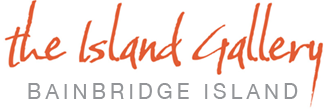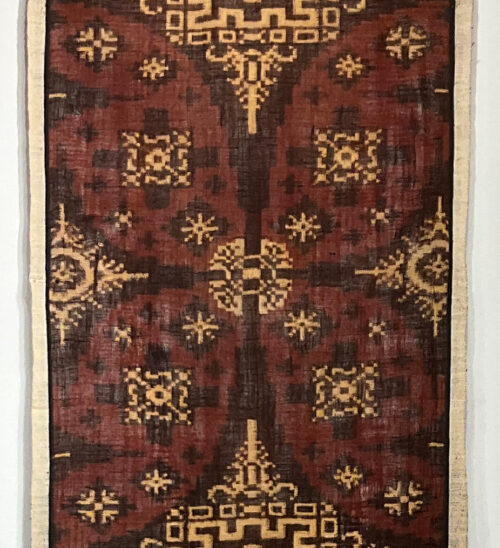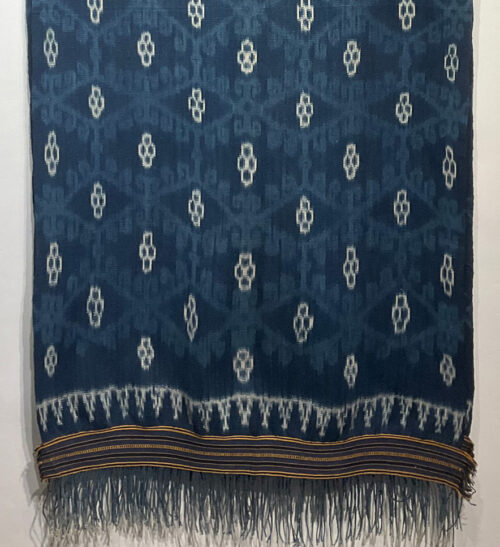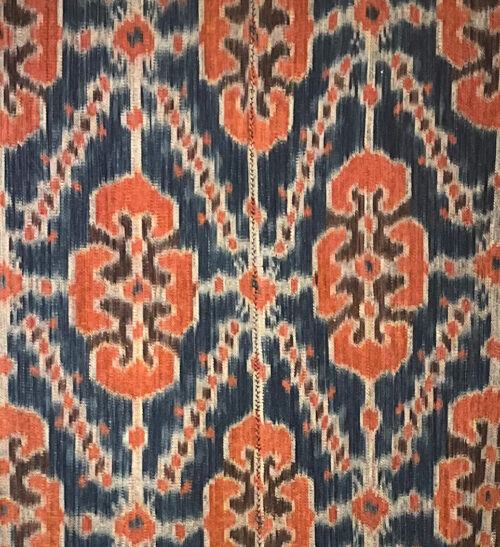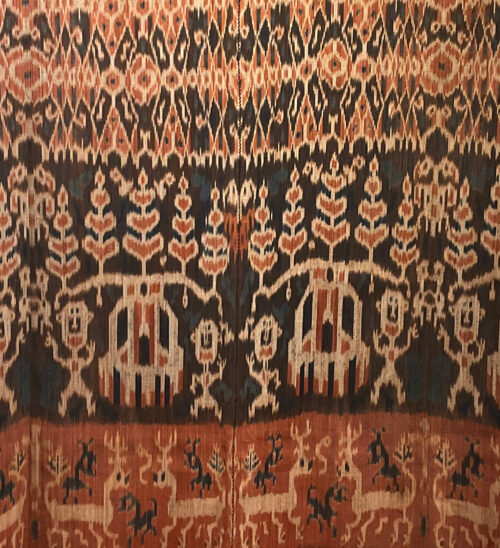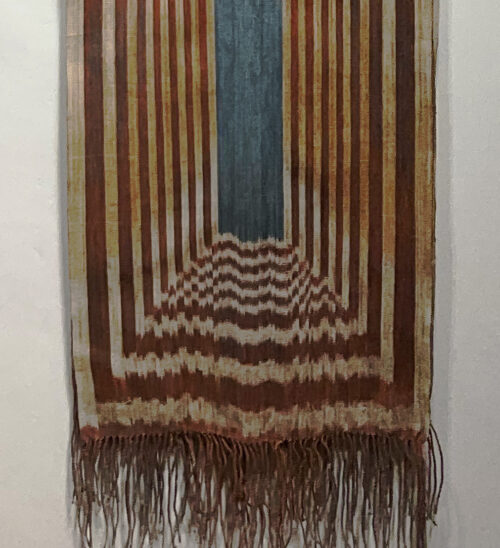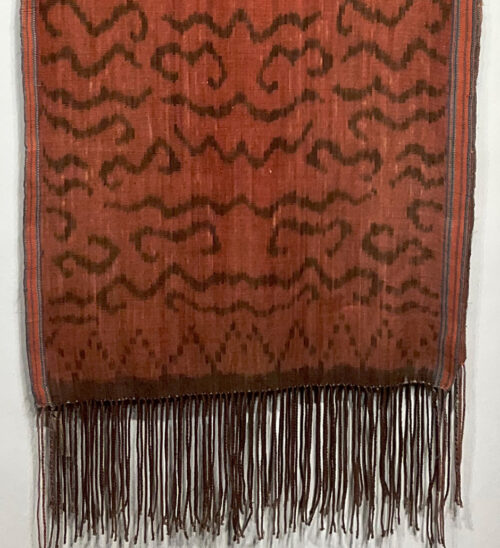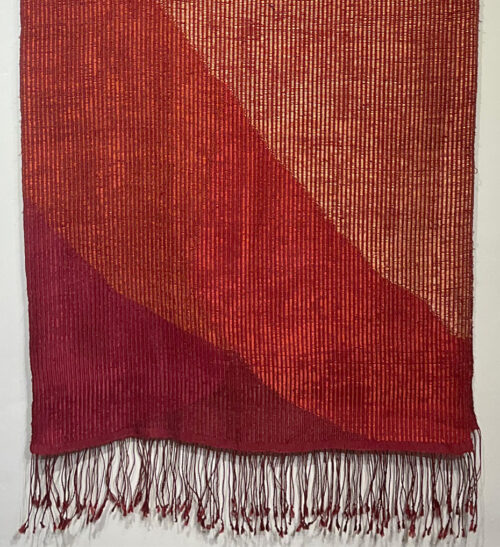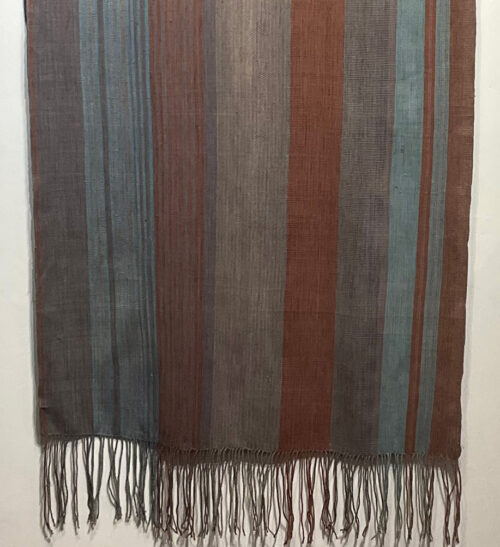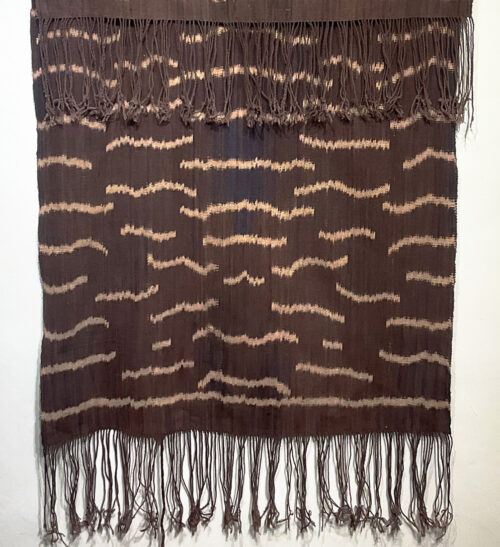-
This double ikat, called a kamben geringsing cloth, was created in the Balinese village of Tenganan, one of three places in the world (Tenganan, Indonesia, India and Japan) that make this intricate and symbolic textile. Tenganan is world-famous among textile technologists; creation of the double ikat involves a technique in which resist patterns are applied to both the warp and weft before weaving, so that the final pattern appears only on completion. The symbols, colors and the process itself are integral to Balinese society. The Star motif throughout the ikat signifies the time when the god Indra, honored as the creator of the first human beings, was reveling in the radiance of the moonlight and the beauty of the stars. These resolved themselves into images and patterns which from that time onward were destined to become the sacred cloths of the first Balinese. The god Indra then taught the girls and women the art of making double ikat cloths. The textiles are used in important community and family rituals, and through their magical potency serve to protect the people of the community from the threat of defilement and decay. The textiles are worn as costume, showing rank, become part of dowries, gifts and as signifiers of family wealth. In this double ikat, the most striking and characteristic feature is its muted coloring, combining red and reddish-brown tones, eggshell and dark blue or black-violet. The cloth is woven in loose tabby from cotton yarns and incorporates geometric symbols. For further information on the double ikat, please contact the Gallery.
-
The Indigo Ikat has a repeating geometric patola ratu motif, based on eight-rayed flower pattern from the Indian silk patola cloths traded in the 16th and 17th centuries by the Dutch to Sumbanese kings. This pattern is traditionally associated with Sumbanese royalty and continues to be used in ceremonial textiles for funerals and weddings and in dowries. These textiles confer magical qualities to those who wear or display them and represent personal wealth.
This warp ikat is made of cotton, hand dyed and woven on Sumba Island, Indonesia. This ikats is wonderful displayed as a wall hanging.
-
The Men's Hinggi Ikat has a repeating geometric patola ratu motif, based on eight-rayed flower pattern from the Indian silk patola cloths traded in the 16th and 17th centuries by the Dutch to Sumbanese kings. Another motif on this ikat is the feline mahan, representing a lion or tiger, and symbolic of power and courage. These patterns are traditionally associated with Sumbanese royalty and continue to be used in ceremonial textiles for funerals, weddings, and in dowries. These textiles confer magical qualities to those who wear or display them and represent personal wealth. The Men’s Hinggi warp ikat is hand dyed and woven on Sumba Island, Indonesia. This ikat is wonderful exhibited as a wall hanging.
-
The Indigo Ikat has a repeating geometric patola ratu motif, based on eight-rayed flower pattern from the Indian silk patola cloths traded in the 16th and 17th centuries by the Dutch to Sumbanese kings. This pattern is traditionally associated with Sumbanese royalty and continues to be used in ceremonial textiles for funerals and weddings and in dowries. These textiles confer magical qualities to those who wear or display them and represent personal wealth.
Another motif is the walamangata tree from which ropes and fishing lines are made, and important to the Sumbanese economy. The Sumbanese interpret the walamangata tree as the Tree of Life; staying close to and guarding the king who will in turn be their source of wealth and food. A third motif is the ruha or deer, representing the king. The hunting of deer was reserved for royalty and the deer motif was retained for textiles of the royal court: the larger the deer’s antlers the higher the wearer’s position.
The Men’s Hinggi warp ikat is hand dyed and woven in the Kembera district, Sumba Island, Indonesia, c. 1980. This ikat is wonderful exhibited as a wall hanging.
-
Lou Zeldis Ikat
This Portal design is an iconic motif from Lou Zeldis, a bit of trompe d’oeil. Because of its length, this ikat would be spectacular as a wall hanging in a home with extra tall cathedral ceilings. Shown here folded.
-
Out of stock
Lou Zeldis Ikat
The Red Tiger Motif Ikat is designed by Lou Zeldis. It is made of 100% cotton, hand dyed and woven on Sumba Island, Indonesia. Lou was active in striving to preserve Indonesian textile traditions, especially the ikat of Sumba. Ikats can be exhibited as wall hangings, table runners, displayed atop furniture, or wrapped as a shawl. -
This silk weft ikat, from the Isaan region of Thailand, has a contemporary abstract design. It is 100% silk and hand dyed. This ikat can be exhibited as wall hangings, table runners, displayed atop furniture, or wrapped as a shawl.
-
Out of stock
Lou Zeldis Ikat
This striped Ikat is designed by Lou Zeldis. Made of cotton, hand dyed and woven on Sumba Island, Indonesia. Lou was active in striving to preserve Indonesian textile traditions, especially the ikat of Sumba. Ikats can be exhibited as wall hangings, table runners, displayed atop furniture, or wrapped as a shawl. -
Lou Zeldis Ikat
The Tiger Motif warp ikat is designed by Lou Zeldis. Made of cotton, hand dyed and woven on Sumba Island, Indonesia. Lou was active in striving to preserve Indonesian textile traditions, especially the ikat of Sumba. The ikats can be exhibited as wall hangings, table runners, displayed atop furniture, or worn as a shawl.
